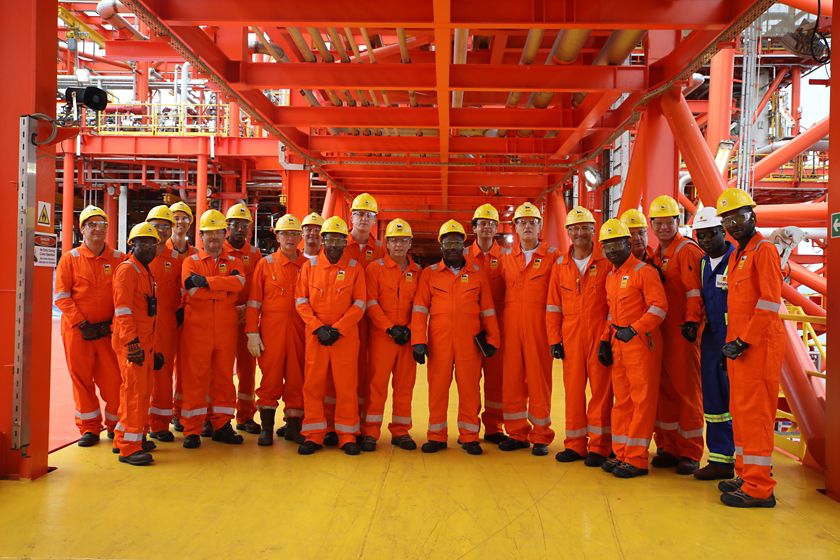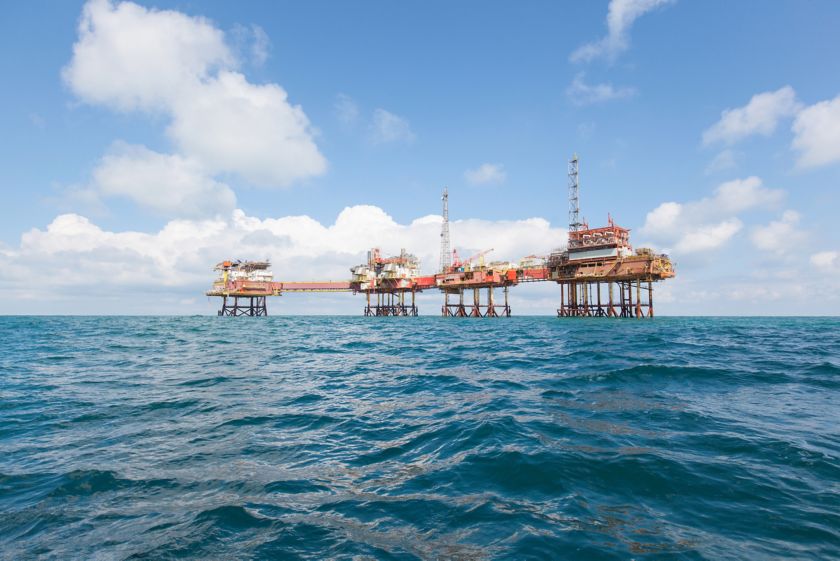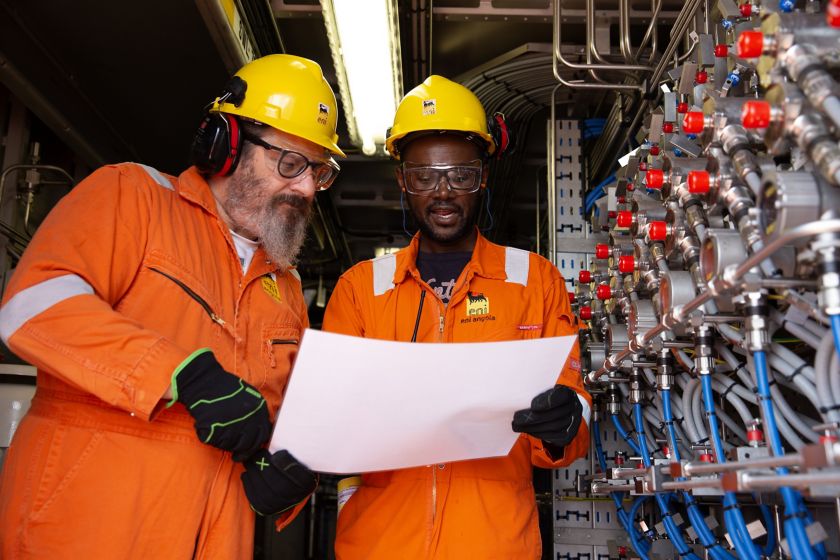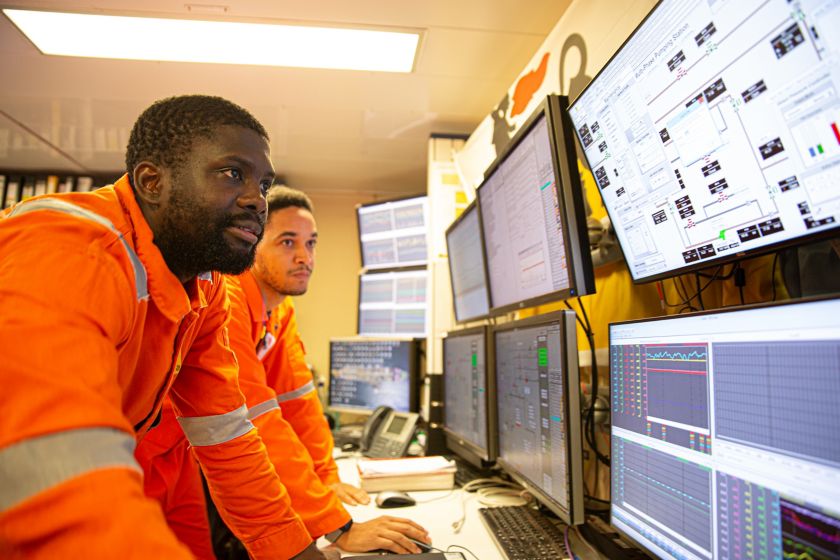Type of activity
Oil & Gas

Or , our new artificial intelligence tool.

The East Hub and West Hub projects in Angola are a model of our way of operating in the Oil&Gas sector, which is based on the application of innovative technologies and the ability to reach the market in a short time frame. Our operational strategy in Angola is based on some of the cornerstones of our Upstream model, starting with the integration and overlapping of the exploration and development phases. No less important is near field exploration, which allows us to use the facilities that are already in place to quickly start possible new production.
In addition to the natural resources sector, where we operate through the Azule Energy joint venture, in Angola we are also active in the field of renewables with the Caraculo photovoltaic project. We are also developing a programme for the decarbonization of the country in accordance with the principles of the circular economy, in particular through sustainable crops to produce biofuels.
Country: Angola
Activity start date: 2009 – present
In the East Hub and West Hub projects in Angola, within Block 15/06, we apply innovative digital and experimental geoscience technologies to exploration. They allow us for example to acquire three-dimensional data and images of the subsurface and rocks. The Infrastructure Led Exploration (ILX) campaign and its overlapping with the development phase (fast track approach) allow the discoveries we make to reach the market quickly. This allows the different planning phases to proceed in parallel and existing facilities to be used wherever it is possible to optimise time and costs and quickly make new discoveries operational. The fields of Cuica and Cabaça North - through the FPSO Armada Olombendo (floating production, storage and offloading ) facility - and Ndungu Early Production - through the connection to the FPSO Ngoma - are already operational. N'Goma and Olombendo, were not built from scratch, but from existing vessels that were converted specifically for the occasion.
The Agogo Integrated West Hub project, a strategic extension of the West Hub in Block 15/06, is also on stream. Agogo IWH integrates the Agogo and Ndungu fields under Eni’s Low Carbon, Fast Track model, which enabled start-up in record time, just 29 months after the Final Investment Decision (FID). The Agogo FPSO, the heart of the project, is the first in Angola where operational emissions are fully offset, thanks to cutting-edge technologies such as the offshore combined cycle and a pilot Carbon Capture and Storage (CCS) unit.

Personnel at work on board an FPSO

The platform off the Angolan shore


Maximum attention in the control room
We carefully implement specific regulations, such as the Zero Discharge Policy for the management of production water and drilling residue. We use the best available technology and focus on technological innovation to minimise discharge and emissions into the atmosphere. We work on the reuse of gas associated with extraction and energy recovery and are committed to preventing spills from our facilities with emergency plans approved by the competent authorities.
estimated Agogo production peak (thousand barrels of oil equivalent)
drilled in East and West Hub
undersea pipelines installed
oil treatment capacity installed in the Block (thousand barrels per day)
The project’s start-up was made possible by the Agogo FPSO, the first in Angola where operational carbon emissions are fully offset.
Eni started production from Ndungu Early Production (EP) development project.
Eni started production from Cabaça North development project.
Eni reports the start-up of its offshore Agogo oilfield.
Eni has made a new light oil discovery in Block 15/06, in Angola’s deep offshore.
Eni started production from the Vandumbu field in Block 15/06.
First oil for the floating production, storage and offloading ) facility Olombendo from Cabaça field.
The floating production, storage and offloading facility arrives in the block.
First Oil reached from Cinguvu field, in the West Hub.
FPSO N'Goma starts production from the Sangos field.
JV approves General Development and Production Plan for East Hub.
Cabaça North-1 exploratory well built
Our local development projects are designed to promote community growth based on the specific needs of the areas, creating value over time.
On 14th October 2016, we celebrated, along with our Angolan partner Sonangol, the launch of FPSO Armada Olembendo in Singapore.
30 January 2017

If you want to change topic, clear the chat and make a new query to receive more relevant results.
This will delete the question history.
If you want to change topic, clear the chat and make a new query to receive more relevant results. This will delete the question history.
Here you can find the full list of your queries.
The answers are generated by artificial intelligence, therefore they may contain inaccuracies. Please read the terms and conditions of use.

EnergIA is an innovative tool based on artificial intelligence capabilities, which can help you navigate the contents of eni.com, quickly finding answers to your questions. EnergIA can also perform a search on a specific topic, providing the most up-to-date data available, or it can invite you to delve deeper into a topic of your interest by suggesting links and specific readings. Start now!
EnergIA is an innovative tool based on artificial intelligence capabilities, which can help you navigate the contents of eni.com, quickly finding answers to your questions. Start now!
EnergIA (ener'dʒia) is a system based on Generative Artificial Intelligence.
Thanks to this technology, we can respond to your requests by querying the most relevant content and documents available on eni.com. (Note: financial documents from the last 12 months and press releases from the last 2 years are considered.)
Through EnergIA, you can delve into topics of interest and have a real-time window into the world of Eni.
If you wish to search for a specific document, press release or news, use the traditional search engine via the magnifying glass icon.
Like all systems that leverage Generative Artificial Intelligence, EnergIA may generate inaccurate or outdated responses. Always consult the sources that EnergIA proposes as the origin of the generated information.
If the system fails to find an exact match for the requested content, it still tends to provide a response.
If you find any inaccuracies in the provided response, please send us your feedback at the bottom of the page: it will be very helpful for us to improve.
Remember that the content generated by the system does not represent Eni’s official position. We therefore invite stakeholders to refer to their designated contacts for official statements: Press Office for journalists, Investor Relations for analysts and investors, Company Secretariat for shareholders etc..
EnergIA can understand questions posed in almost all languages, but we prefer to provide you with a response in English or Italian, the two languages available on eni.com. If you ask a question in Italian, the content on the site in Italian will be consulted. If you ask it in English or any other language, the content in English will be consulted. (Note: the language Eni uses for financial documents/content is predominantly English.)
If questions are formulated that violate the set security criteria, the system will not proceed with processing the response. Please remember not to send personal data.
By using this service, the users acknowledge that they have read and accepted the terms and conditions of use.
Search
EnergIA (ener'dʒia) is a system based on Generative Artificial Intelligence.
Thanks to this technology, we can respond to your requests by querying the most relevant content and documents available on eni.com. (Note: financial documents from the last 12 months and press releases from the last 2 years are considered.)
Through EnergIA, you can delve into topics of interest and have a real-time window into the world of Eni.
If you wish to search for a specific document, press release or news, use the traditional search engine via the magnifying glass icon.
Like all systems that leverage Generative Artificial Intelligence, EnergIA may generate inaccurate or outdated responses. Always consult the sources that EnergIA proposes as the origin of the generated information.
If the system fails to find an exact match for the requested content, it still tends to provide a response.
If you find any inaccuracies in the provided response, please send us your feedback at the bottom of the page: it will be very helpful for us to improve.
Remember that the content generated by the system does not represent Eni’s official position. We therefore invite stakeholders to refer to their designated contacts for official statements: Press Office for journalists, Investor Relations for analysts and investors, Company Secretariat for shareholders etc..
EnergIA can understand questions posed in almost all languages, but we prefer to provide you with a response in English or Italian, the two languages available on eni.com. If you ask a question in Italian, the content on the site in Italian will be consulted. If you ask it in English or any other language, the content in English will be consulted. (Note: the language Eni uses for financial documents/content is predominantly English.)
If questions are formulated that violate the set security criteria, the system will not proceed with processing the response. Please remember not to send personal data.
By using this service, the users acknowledge that they have read and accepted the terms and conditions of use.
A new window into Eni’s world, at your disposal. EnergIA is an innovative tool based on artificial intelligence capabilities, which can help you navigate the contents of eni.com, quickly finding answers to your questions.
